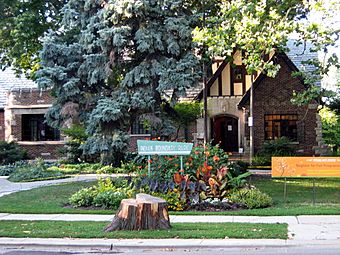Indian Boundary Park facts for kids
|
Indian Boundary Park
|
|

Indian Boundary Park Fieldhouse
|
|
| Location | 2500 W. Lunt Ave Chicago, Illinois |
|---|---|
| Area | 13 acres (5.3 ha) |
| Architect | Gloede, Richard F.; Hatzfeld, Clarence |
| Architectural style | Tudor Revival |
| MPS | Chicago Park District MPS |
| NRHP reference No. | 95000485 |
Quick facts for kids Significant dates |
|
| Added to NRHP | April 20, 1995 |
Indian Boundary Park is a cool, green space covering about 13 acres in the West Ridge area of North Side, Chicago, Illinois. It's a fun place for families and has a unique history.
Park History and Name
Indian Boundary Park first opened its gates in 1922. The park's name comes from an important historical event. It's named after a special boundary line. This line was set up in 1816 as part of the Treaty of St. Louis.
This treaty was an agreement between the United States government and three Native American tribes: the Odawa, Ojibwe, and Potawatomi peoples. The boundary line from this treaty actually ran right through where the park is today!
A Park with a Former Zoo!
Believe it or not, Indian Boundary Park used to have its very own small zoo! It started with just one black bear. Over time, the zoo mostly housed friendly farm animals. You might have seen goats, ducks, and chickens living there.
The Lincoln Park Zoo's Zoological Society helped take care of the animals. Sadly, the zoo at Indian Boundary Park closed in 2013. The few remaining animals were moved to the Lincoln Park Zoo.
Park Features and Fieldhouse
Indian Boundary Park is well-known for its beautiful fieldhouse. This building was finished in 1929. Its design is special because it mixes two styles: Native American elements and Tudor architecture.
In 1989, a big playground was added to the park. People from the neighborhood even helped build it! The park is so important that it was added to the National Register of Historic Places in 1995. The fieldhouse itself was named a Chicago Landmark in 2005.
On May 20, 2012, the historic fieldhouse was badly damaged by a fire. But don't worry, restoration work began in late 2013. Thanks to a lot of effort, including help from the park supervisor Philip Martini, the fieldhouse was fully restored and reopened on July 14, 2014.


